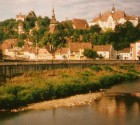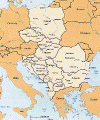



![]()
Translyvania - Land Beyond The Forest
"Poverty reigns in Translyvania, but it is a distinguished poverty."
Walter Starkie, Raggle-Taggle, 1933
Brasov is the second largest city in Romania. Located in the south-eastern part of Translyvania, it was first built by German settlers (known as `Saxons') who were invited here by the Hungarian princes 700 years ago. The Germans built seven towns, including Brasov (called Kronstadt by the Saxons), Sighisoara (Schassburg) and Cluj-Napoca (Klausenberg), and hence the German name for Transylvania - Siebenburgen ("Seven Towns"). The German presence enriched the cultural and economic life of Transylvania but their presence has declined since the 1989 Revolution, after which the Germans were given the freedom to leave Romania. Most of the 300,000 Transylvanian Saxons have since left for Germany. Seven hundred years of German presence of Transylvania had thus come to an end. Their only legacy were the many German medieval cities in the middle of an Eastern Orthodox Romania.
(I met a German tourist in Brasov who told me about his great love for Transylvania (& the great hiking routes) and that it saddens him that the Saxons are now leaving here. I sympathised with his sentiments - until he started saying that the Holocaust didn't occur and so on...)
Brasov is one of those German towns that has retained its German mediaeval architecture. The Black Church (Biserica Neagra - so named because of its soot-blackened walls) and Saxon Town Hall (1420) at the central city square - Piata Sfatului had a distinctively German air. Having a meal at a good restaurant at the Piata is cheap, at about US$2.50 per meal, and with a bottle of local wine thrown in at less than US$4.


Sighisoara was the birth-town of Vlad Tepes, Prince of Walachia, better known as Dracula. He was a Romanian national hero who fought bravely against the Turks, Germans and Hungarians. Also known for his cruelty (he once invited a number of noblemen to a state banquet, and then had all of them slaughtered), his German enemies spread rumours about his being a vampire. In the 19th century, the British writer Stoker turned him into a vampire. Also an old German town like Brasov, Sighisoara is full of twining little streets and sitting in the village squares were old Hungarian ladies in traditional dresses. It's like travelling back to history.

![]() To Bucharest, Romania's capital
To Bucharest, Romania's capital
 Back to TWC's Mad Rush Homepage
Back to TWC's Mad Rush Homepage
 TWC's Homepage
TWC's Homepage
 Please email your comments to weecheng@post1.com
Please email your comments to weecheng@post1.com